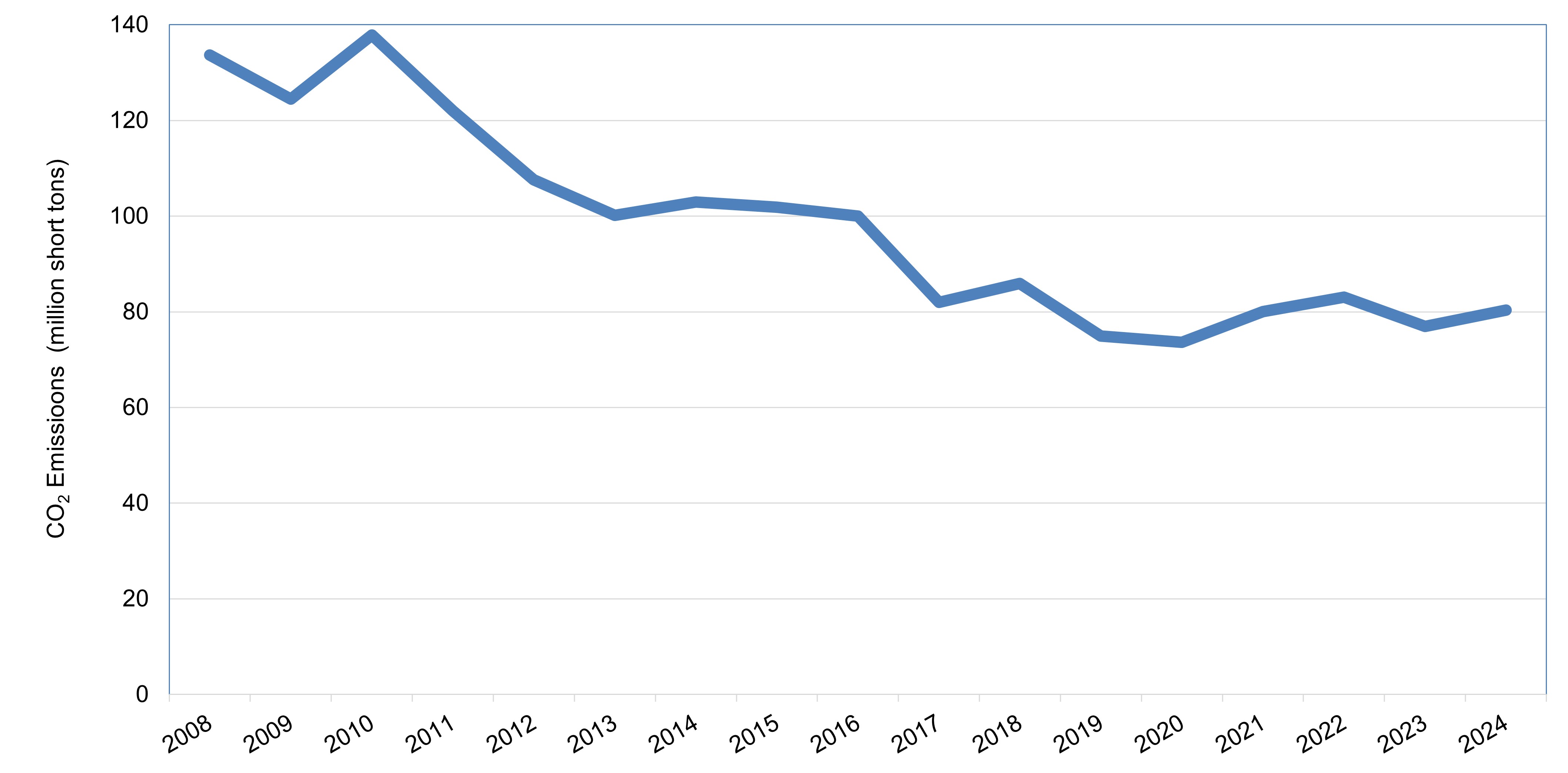CO2 Emissions in the RGGI 10 States

The chart above shows the change in CO2 emissions from the power sector since RGGI’s inception in the ten fully participating RGGI states (Connecticut, Delaware, Maine, Maryland, Massachusetts, New Hampshire, New Jersey1, New York, Rhode Island, and Vermont). CO2 emissions from these states have fallen by 43% compared to a 2006-2008 baseline, faster than the emissions reduction across the U.S. as a whole.
1While New Jersey emissions are included in the above chart, New Jersey was not a participating RGGI state from 2011 through 2020. In addition, Virginia participated in RGGI from 2020 through 2023, but Virginia emissions are not included here.
Emissions Monitoring & Reporting
Each state's CO2 Budget Trading Program regulations require each CO2 budget unit to install and certify monitoring systems and to collect, record, quality-assure, and report data necessary to quantify CO2 mass emissions. Emissions data for RGGI CO2 budget sources (emitters) is recorded in the U.S. Environmental Protection Agency's (U.S. EPA) Clean Air Markets Program Data (CAMPD) database in accordance with state CO2 Budget Trading Program regulations and U.S. EPA regulations at 40 CFR Part 75 and transferred to RGGI COATS on an automated basis. For more information on U.S. EPA emissions reporting requirements at 40 CFR Part 75, please see the U.S. EPA CAMPD website and the Plain English Guide to the Part 75 Rule. State CO2 Budget Trading Program regulations are available here.
Emissions Reports and Data
Interactive CO2 Emissions Dashboard
The RGGI states have developed a publicly available, interactive emissions dashboard which can be used to visualize emissions data and trends from covered sources over the history of RGGI. To learn more and to view the dashboard, click here.
RGGI COATS Emissions Reports
RGGI COATS emissions data is available for public view under the "Public Reports" tab on the homepage of the RGGI COATS platform. RGGI COATS Emissions Reports are available quarterly, annually, and by compliance period and include the facility name, facility ID (ORIS code), unit ID, state ID, operating time, operating hours, CO2 emitted, heat input, and CO2 emissions related to the use of eligible biomass fuel.
To view Emissions Reports, go to the RGGI COATS platform and click on the desired report category (quarterly, annual, or compliance period) in the "Public Reports" menu in the left-hand side of the screen. No login is required. To view historical emissions data from 2000-2008, please see the historical emissions data set, which can be accessed through the link on the right-hand side of this page
RGGI COATS emissions reports include data from the start of the first RGGI control period on January 1, 2009. New emissions data is added to RGGI COATS on a quarterly basis and CO2 budget sources have up to 30 days following the end of a quarter to report emissions data. Emissions data is released to RGGI COATS as it is processed by U.S. EPA and is preliminary, subject to revision arising from quality assurance and quality control review and resolution of technical reporting issues.
CO2 emissions from eligible biomass reduce the total CO2 allowance compliance obligation of the emitting unit. Emissions from eligible biomass should be deducted from the regional total of CO2 emissions for purposes of calculating emissions from CO2 budget sources subject to RGGI CO2 allowance compliance obligations.
In addition, some RGGI states have specific CO2 emissions reporting requirements for certain industrial electric generators. CO2 allowances are retired by a state from the state CO2 allowance budget on behalf of these industrial facilities on an annual basis. The CO2 allowances retired on behalf of these industrial facilities reduce the number of CO2 allowances that comprise the regional CO2 allowance budget.
RGGI COATS emissions reports present some CO2 emissions data for eligible biomass and industrial generation units that are not subject to a CO2 allowance compliance obligation. The Summary Level Emissions reports provide an adjusted table to indicate the total CO2 emissions reported to RGGI COATS less the CO2 emissions that are not subject to a CO2 allowance compliance obligation (eligible biomass and certain industrial generators). The adjusted total shows the total CO2 emissions subject to a CO2 allowance compliance obligation under the regional cap.
Historical Emissions Data
COATS emissions reports contain data beginning in 2009. For prior emissions data, the file below contains CO2 emissions data from regulated power plants in Connecticut, Delaware, Maine, Maryland, Massachusetts, New Hampshire, New Jersey, New York, Rhode Island, and Vermont from 2000-2008.
Cells to the left show year-by-year emissions. Cells to the right show annual emissions expressed as "three-year averages" (i.e. average annual emissions between 2000 and 2002, rather than actual emissions for 2000, 2001, and 2002). Additional tabs include plant-specific emissions for each state.
Historical Emissions (Updated 11.18.09)
Data on Other Pollutants from RGGI Sources
The RGGI states’ CO2 Budget Trading Programs regulate only CO2 emissions from the power sector. However, each of the participating states have other policies and programs in place to regulate other types of pollutants and emissions from other sectors. For more information on a specific state’s activities related to other emissions programs, refer to the State Program Contacts. Included below are some resources from the U.S. EPA for emissions programs and data beyond the scope of RGGI.
- National Ambient Air Quality Standards
- Greenhouse Gas Emissions Inventory
- Clean Air Markets Program Data (CAMPD)
Electricity Monitoring Reports
As part of RGGI's design process, the participating states determined that regular reports would be made to monitor and track power generation serving load in the RGGI region, as well as the emissions associated with that generation.
